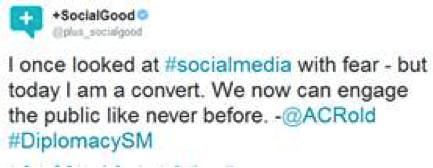Diplomacy is a centuries-old tradecraft and art. The emergence of the internet just made it more interesting, more relevant, and more complex than ever before.
On April 22nd in Washington DC, the Diplomatic Courier, United Nations Foundation, and the Digital Diplomacy Coalition held an event exploring the future of public diplomacy in the digital age. People around the world joined the conversation through Twitter and Livestream, bringing questions and insights from countries such as Nigeria, Australia, Mexico, and Turkey.
While speakers represented a diverse group of countries, professions, perspectives, and corporations, some common themes were clear. Here are four takeaways from the Diplomacy +SocialGood event and dialogue:
Collaboration is still key
Today’s problems cannot be solved by a single sector, and savvy digital diplomats recognize this as their starting point and opportunity. Collaboration has become an everyday reality for successful diplomacy and effective digital diplomacy. A great example of this is the United Nations work on the Millennium Development Goals. By embracing technology and unlikely but effective partnerships (see for example, OCHA) , the United Nations, its global diplomats, and partners has helped make the world a more peaceful and healthy place.
Social media is a two-way street
When using social media, as with anything in diplomacy, it is important to listen to your audience and engage them on a personal level. Answering questions and providing action components work to build an active and trusted platform. It is also imperative to understand the cultural contexts of your audiences and to frame your messages accordingly. A great example of this is the MY World global survey the United Nations is leading with partners, which invites anyone, anywhere to contribute to the post-2015 development agenda.
There is more to a #selfie than meets the eye
Everyone’s got an opinion about the #selfie phenomenon. Whatever your opinion, it says a lot about the way people engage in a digital era. Visuals are a quick and powerful form of communication. From data visualization to the selfie trend we can see the positive impact of having a graphic element when engaging on social media platforms. They work to humanize and individualize diplomatic dialogue. Social media storytelling has visuals at its heart, the modern public diplomacy expert recognizes this as not just a tactic but a truth.
Technology is the tool of the future
Throughout history the diplomatic community has adjusted to new technologies. Using new technologies such as social media, mobile phones, and digital platforms will allow the field to grow in new and innovative ways. It’s because of technology that the conversation in Washington, DC was able to be shared with viewers from Australia to Albania and Armenia. The topic struck the conversation on Twitter especially, with many people commenting on the need to use the tools that technology provides to achieve the United Nations Millennium Development Goals.
The means of diplomacy is ever-evolving. Diplomacy +SocialGood highlighted recent changes while emphasizing that the core goals of diplomacy never change. Effective Public diplomacy is still about people-to-people contact, with individuals at the heart of the matter whether in diplomatic relationships or cultural exchange. Technology and social media can enhance these communications, but it will never replace their power or primacy. Whether promoting interests, values, or ending conflict, diplomacy in the digital age now has digital DNA.
The dialogue continues from this dynamic conversation. Watch the video here and then join the +SocialGood community for similar conversations.



 View All Blog Posts
View All Blog Posts